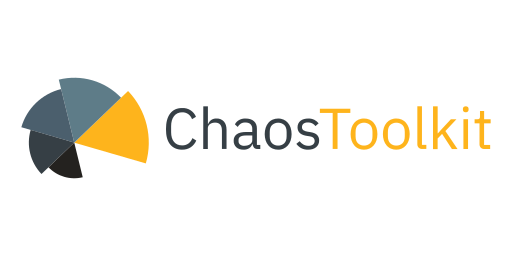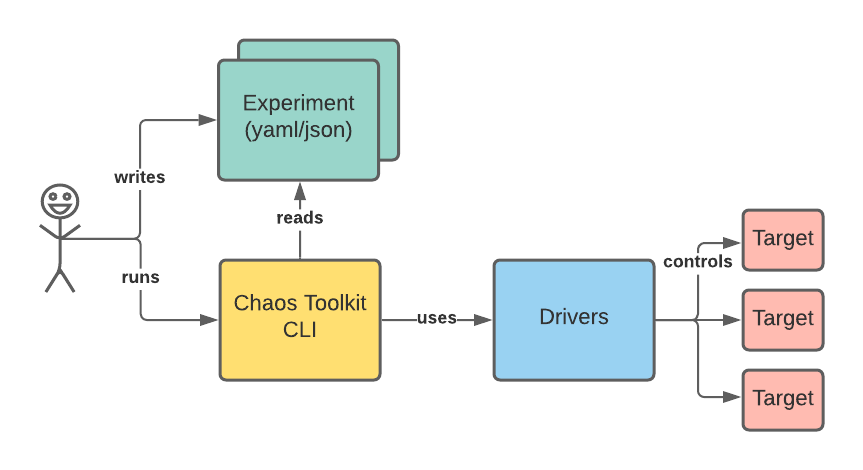What is Chaos Toolkit?

The Chaos Toolkit, often abbreviated as “ctk,” is an open-source toolkit for chaos engineering. This means it helps engineers deliberately inject controlled failures into their systems to proactively discover and address weaknesses before they manifest in real-world scenarios.
Think of it like a stress test for your systems, but on steroids! ctk allows you to simulate various failure scenarios like:
- Network outages: Simulate internet or cloud connectivity disruptions.
- Hardware failures: Simulate disk crashes, memory leaks, or CPU overload.
- Software bugs: Inject specific errors or exceptions into your application code.
- Resource constraints: Simulate limited disk space, memory, or network bandwidth.
By observing how your system reacts to these simulated failures, ctk helps you:
- Identify single points of failure: Find critical components that can bring down the entire system.
- Validate resilience measures: Test the effectiveness of your redundancy and recovery mechanisms.
- Improve fault tolerance: Build systems that can gracefully handle disruptions and maintain service.
- Increase confidence in production: Minimize the risk of outages and unexpected breakdowns.
Top 10 use cases of Chaos Toolkit?
Top 10 Use Cases of Chaos Toolkit:
- Testing Microservices: Inject failures into individual microservices to assess their isolation and impact on the overall system.
- Validating Disaster Recovery Plans: Simulate disaster scenarios like server crashes or data loss to test recovery procedures and failover mechanisms.
- Strengthening CI/CD Pipelines: Introduce chaos experiments into your CI/CD pipeline to catch potential issues before deployment.
- Improving Monitoring and Alerting: Analyze how monitoring systems and alerts respond to simulated failures, ensuring timely notifications and incident response.
- Stress Testing Cloud Infrastructure: Simulate resource scarcity or scaling challenges in cloud environments to optimize resource allocation and resilience.
- Boosting Developer Confidence: Encourage engineers to experiment with controlled failures, fostering deeper understanding of system behavior and building trust in its robustness.
- Uncovering Hidden Dependencies: Identify implicit dependencies between components that might not be documented, leading to better system design and maintainability.
- Evaluating Third-Party Services: Simulate outages or errors in external services your system relies on to assess their impact and potential mitigation strategies.
- Continuously Improving System Design: Integrate chaos experiments into your development process to continuously identify and address weaknesses, leading to a more resilient and adaptive system.
- Promoting a Culture of Resilience: Foster a proactive approach to system failures within your organization, encouraging engineers to prioritize reliability and robustness in their work.
Always remember, Chaos Toolkit is just one tool in a broader chaos engineering approach. It’s crucial to have well-defined objectives and metrics for your experiments to gain meaningful insights and drive continuous improvement.
What are the feature of Chaos Toolkit?
Chaos Toolkit boasts a powerful feature set built for effective chaos engineering:
Experiment Design:
- Declarative experiments: Define experiments using YAML files, making them human-readable and shareable.
- Modular actions and probes: Combine reusable actions (e.g., process kill, network outage) and probes (e.g., HTTP ping, service health check) to build complex failure scenarios.
- Steady-state hypothesis: Define expected system behavior under normal conditions for comparison with post-experiment results.
- Randomization and scheduling: Randomize experiment execution and schedule runs for recurring stress testing.
Experiment Execution:
- Local and remote execution: Run experiments on your local machine or target remote systems.
- Cloud platform integrations: Integrates with major cloud providers (AWS, GCP, Azure) for managing infrastructure and experiments.
- Journal and reporting: Tracks experiment runs, logs outputs, and generates reports for analysis and sharing.
Analysis and Feedback:
- Metrics and dashboards: Monitor key metrics during experiments and visualize results in interactive dashboards.
- Alerting and notification: Set up alerts for critical failures or unexpected behavior during experiments.
- Integration with CI/CD pipelines: Integrate chaos experiments into your CI/CD pipeline for continuous validation of system resilience.
Extensibility and Community:
- Open-source and modular: Contribute to the codebase and extend functionality with custom actions and probes.
- Extensive documentation and tutorials: Access comprehensive documentation and learning resources to get started quickly.
- Active community and support: Join the vibrant Chaos Toolkit community for discussions, collaboration, and troubleshooting.
These are just some of the key features that make Chaos Toolkit a valuable tool for building robust and resilient systems. Its flexibility, power, and community support make it a popular choice for organizations of all sizes across various industries.
How Chaos Toolkit works and Architecture?

Chaos Toolkit works in a well-defined, modular manner to inject controlled failures and analyze their impact on your system. Here’s a breakdown of its key elements and workflow:
1. Experiment Definition:
- YAML files: You define your chaos experiments using YAML files. These files specify the:
- Target system: Where to run the experiment (local machine, remote server, etc.).
- Steady-state hypothesis: Expected behavior of the system in normal conditions.
- Method: Sequence of actions and probes to execute during the experiment.
- Actions: Represent the simulated failures (e.g., process kill, network outage).
- Probes: Monitor system health and behavior during and after the experiment (e.g., HTTP ping, service health check).
2. Experiment Execution:
- Command-line interface (CLI): You trigger experiment execution using the Chaos Toolkit CLI.
- Modular execution: Each action and probe runs independently, allowing for flexible experiment design and reuse.
- Randomization and scheduling: Experiments can be randomized for comprehensive testing and scheduled for recurring stress checks.
3. Data Collection and Analysis:
- Journal: Chaos Toolkit keeps a detailed log of each experiment run, including timestamps, actions, probe results, and system outputs.
- Metrics and dashboards: Key metrics during the experiment (e.g., response times, error rates) are collected and visualized in interactive dashboards.
- Comparison with steady-state hypothesis: Post-experiment results are compared against the initial hypothesis to identify deviations and analyze system behavior under stress.
4. Reporting and Feedback:
- Reports: Chaos Toolkit generates detailed reports summarizing the experiment’s execution, results, and insights.
- Alerting and notification: You can configure alerts for critical failures or unexpected behavior during the experiment.
- CI/CD integration: Chaos experiments can be integrated into your CI/CD pipeline to perform automated resilience testing at each stage.
Architecture:
Chaos Toolkit follows a modular architecture consisting of:
- Core: Provides the foundation for experiment execution, management, and reporting.
- Extensions: Offer additional functionalities like cloud integrations, custom actions and probes, and advanced reporting capabilities.
- Plugins: Allow further customization and integration with external tools and platforms.
This modular design makes Chaos Toolkit flexible and extensible, allowing you to tailor it to your specific needs and environment.
Benefits of Chaos Toolkit Architecture:
- Simplicity and clarity: The modular structure makes it easy to understand and use, even for beginners.
- Extendability and customization: You can easily add new features and integrations through extensions and plugins.
- Community contributions: The open-source nature encourages code contributions and continuous improvement.
How to Install Chaos Toolkit it?
Installing Chaos Toolkit is straightforward and can be done in two main ways:
1. Using pip:
This is the recommended method for most users and requires Python 3.5 or later.
- Open a terminal or command prompt.
- Run the following command:
pip install chaostoolkit
This will install the core functionalities of Chaos Toolkit.
2. Using Docker:
This method is convenient for isolating the environment and can be useful for containerized setups.
- Ensure you have Docker installed and running.
- Run the following command to pull the latest stable image:
docker pull chaostoolkit/chaostoolkit:latest
You can then run Chaos Toolkit commands by referencing the Docker image:
docker run chaostoolkit/chaostoolkit:latest chaos run experiment.json
Additional Options:
- Virtual environment: Consider creating a virtual environment for isolation, especially if you have multiple Python versions.
- Upgrade: Use
pip install -U chaostoolkitto update your existing installation. - Extensions: If you need additional functionalities, install specific extensions using
pip install chaostoolkit-<extension_name>.
Basic Tutorials of Chaos Toolkit: Getting Started

Let’s delve into the exciting world of Chaos Engineering with step-by-step basic tutorials for Chaos Toolkit:
1. Setting Up:
- Prerequisites: You’ll need Python 3 and pip installed. Optionally, install a virtual environment for cleaner management.
- Install Chaos Toolkit: Open a terminal and run
pip install chaostoolkit. - Verify Installation: Run
chaos initand follow the prompts. This creates a default configuration file and confirms everything is ready.
2. Your First Experiment:
- Target: We’ll target a simple HTTP service running on your local machine (modify if yours is different).
- Chaos Type: Let’s simulate network delays using the
network-delayexperiment. - Steps:
- Create a YAML file named
experiment.yamlin your preferred working directory. - Paste the following content, adjusting the
targetURL if needed:
- Create a YAML file named
YAML
experiment:
name: basic-network-delay
hypothesis: The service should gracefully handle network delays.
actions:
- name: delay-network
chaos:
type: network-delay
target: http://localhost:8000
delay: 5s
- name: measure-response-time
probe:
type: ping
target: http://localhost:8000
analysis:
compare:
baseline: before.json
current: after.json
metric: response_time
jobs:
- name: run-experiment
steps:
- name: run-actions
action: experiment.actions
3. Run the experiment: `chaos run experiment.yaml`
- Explanation: This experiment introduces a 5-second network delay for the target service and then measures its response time before and after the chaos. The results are stored in
.jsonfiles for comparison.
3. Expanding Your Skills:
- Advanced Chaos Types: Explore other chaos types like pod-chaos, resource-stress, and more to simulate diverse failures.
- Chaostypes and Fault Injection: Chain multiple chaos types for complex stress scenarios or write custom Chaostypes for specific needs.
- Chaos Schedules and Automation: Integrate Chaos Toolkit with CI/CD pipelines for automated testing or schedule experiments at specific times.
- Chaos Reports and Analytics: Generate detailed reports analyzing experiment results and system behavior.
Happy chaossing!
Say goodbye to the hassles of bike ownership! MotoShare.in offers affordable rentals, whether you need a scooter for errands, a bike for a road trip, or a reliable ride to explore new cities.

 Starting: 1st of Every Month
Starting: 1st of Every Month  +91 8409492687
+91 8409492687  Contact@DevOpsSchool.com
Contact@DevOpsSchool.com
